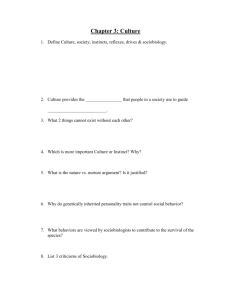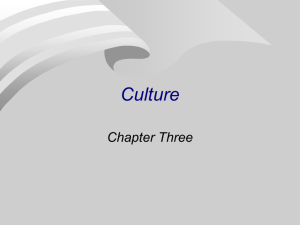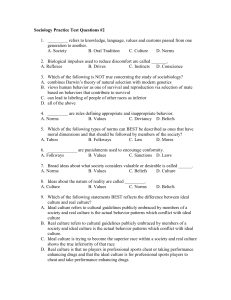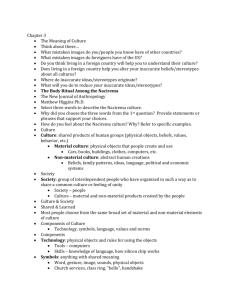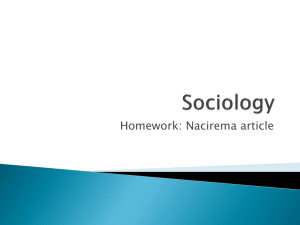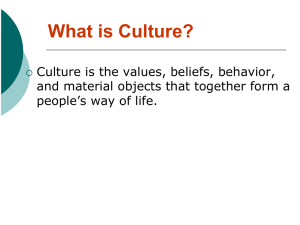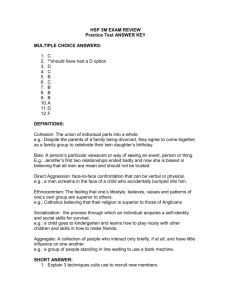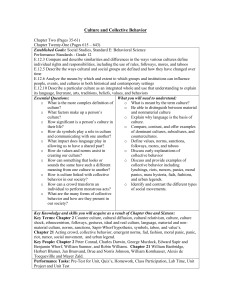Chapter 3
advertisement
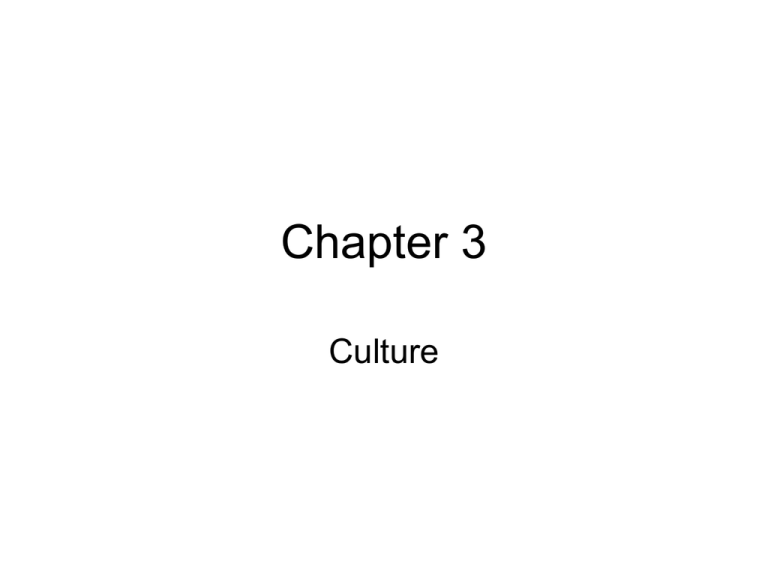
Chapter 3 Culture The basis of culture • Knowledge, language, values customs and physical objects that are passed from generation to generation among members and groups • Material side: the physical makeup of the country • Nonmaterial side: cultural diversity, beliefs, rules etc. Culture and Society • Both are linked together. One can not exist without the other but are not the same • Society- a group of people who live in a defined territory and participate in a common culture • Culture- is that societies way of life Culture and Heredity • Instincts- genetically inherited patterns of behavior – Nonhuman animals have the ability to live on instinct alone to survive • If we as humans went on instinct alone we would all act the same – All women would want and have children at a specific time of year, eat the same food, live in the same place, etc. Heredity and behavior • Nature vs. nurture – Does your genetic make up make you who you are? – Does your environment make you who you are? • Research show it is 50-50 Reflexes and drives • Reflex- simple biological automatic reaction – Pupils contract in bright light, rooting • Drives- impulses to reduce discomfort – Eating, sleeping etc – In some cultures people are taught to ignore their Drives Sociobiology • Study of biological basis of human behavior – Natural selection and modern genetics • According to Darwin the best suited survive and adapt while the rest perish • Human survival – Parental affection and care, friendship, sexual reproduction and education Major criticism of Sociobiology • Importance placed on genetics alone could be use to justify inferior or superior races • To much variation of the study world wide • However some believe that is can be used along with culture to get a better understanding of human nature and social life Section 2 language and culture • Symbols- things that stand or represent something else – Confederate flag represents oppression for African Americans but represents a proud sense of culture for white southerners – A strong hand shake in America represents confidence (positive). In many Asian countries it represents dominance and is taken as a negative Language and culture • Language can be used to explain and educate – a child does not need to be burned to know that fire is hot and should not be touched. – This can be explained using language. Sapir-Whorf Hypothesis • Hypothesis of linguistic relativity – Our idea of reality depends largely upon language • The more important something is the more words we have to describe it • The less important there may be only one word or no words at all to describe it • This will vary from culture to culture Reality as we know it • Ones perception of the world many change as they learn new language and experience different culture – Not common but is possible Reality as we know it • Cultural difference also play a huge role – Japan- very thin walls; therefore they have no issues with noise – American businessman staying in Japan often are bothered by the “noise pollution” because they are not trained to screen it out. – A person who grew up in the city and moved to the country will awake started because they are not used to the quiet Section 3-Norms and Values • Norms- rules defining appropriate and inappropriate behavior – In Africa a women might become engaged to a man she had never met – Binding a a baby girls foot in China so she may have tiny feet when she is older norms • Norms are learned in a society and are used to guide their social behavior • We are often not aware of these norms until they are broken – In 1960s TV show a female wore Capri pants on TV and there was extreme uproar • This behavior way against the norms for women on TV to be portrayed Three types of Norms • Folkways- rules that cover customary ways of thinking, feeling and behavior but lack moral overtones • Mores- norms that have moral dimension and that should be followed by all members of society • Laws-norms that are formally defined and enforced by officials folkways • Examples- expressing your self in a different manner that may seem odd – People who are covered in tattoos, have strange piercings, dye their hair crazy colors • Folkways may change over time Mores • Morality related to right and wrong – Conformity leads to strong social approval – Violation of this type of norm brings strong disapproval • Ex: not standing for the national anthem would be breaking with the social norms of society Taboo • Is a norm so strong that its violation demand punishment – Incest is the one taboo that crosses all societies Laws • Norms that are formally defines and enforced by officials – In some instances mores and even folkways will become laws with pressure from an evolving society – Ex: smoking was legal everywhere and eventually became outlawed in many public places across America Sanctions • Rewards and punishments used to encourage conformity to norms – Formal and informal • Formal Sanctions- positive or negative – Given to specific people • Ex: teachers, judges, parents • Informal sanctions- positive or negative – Can be applied by most members of a group • Ex: social etiquette: thanking someone who helped you Values • Ideas that most people in society consider to be desirable – These values can and will vary as society changes or even with in different groups of the same society –
